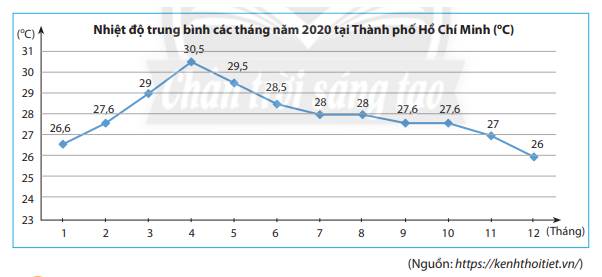
Hãy nhập câu hỏi của bạn vào đây, nếu là tài khoản VIP, bạn sẽ được ưu tiên trả lời.


Xét 2 tam giác ABC và MNP có:
AB=MN (gt)
\(\widehat {BAC} = \widehat {NMP}\) (gt)
AC=MP (gt)
Vậy \(\Delta ABC = \Delta MNP\)(c.g.c)

Xét \(\Delta ABC\) và \(\Delta MNP\) có:
\(\begin{array}{l}AB = MN\\BC = NP\\AC = MP\end{array}\)
Vậy\(\Delta ABC\) =\(\Delta MNP\)(c.c.c)
Xét \(\Delta DEF\) và \(\Delta GHK\) có:
\(\begin{array}{l}DE = GH\\EF = HK\\DF = GK\end{array}\)
Vậy\(\Delta DEF\)=\(\Delta GHK\) (c.c.c)

Em thấy bạn Vuông nói đúng
Để chứng minh điều này, ta có thể chỉ ra trường hợp 2 góc bằng nhau nhưng không đối đỉnh.
Ví dụ:

\(\widehat {{O_1}} = \widehat {{O_2}}\) nhưng hai góc này không đối đỉnh

+ Biểu đồ biểu diễn nhiệt độ trung bình các tháng năm 2020 tại Thành phố Hồ Chí Minh.
+ Đơn vị thời gian là tháng, đơn vị số liệu là độ C.
+ Tháng 4 có nhiệt độ trung bình cao nhất.
+ Tháng 12 có nhiệt độ trung bình thấp nhất.
+ Nhiệt độ trung bình tăng trong những khoảng thời gian từ tháng: 1 – 2; 2 – 3; 3 – 4.
+ Nhiệt độ trung bình giảm trong những khoảng thời gian từ tháng: 4 – 5; 5 – 6; 6 – 7; 8 – 9; 10 – 11; 11 – 12.
+ Nhiệt độ trung bình không đổi trong những khoảng thời gian từ tháng: 7 – 8; 9 – 10.

Đổi 30 phút = 0,5 giờ
Quãng sông từ A đến B dài là:
\(x\) \(\times\) 0,5 + y \(\times\) 1 = 0,5\(x\) + y (km)
Kết luận Quãng đường từ A đên B dài: 0,5\(x\) + y (km)

Lời giải:
Áp dụng tính chất tổng 3 góc trong 1 tam giác bằng $180^0$
Hình 1: Hình không rõ ràng. Bạn xem lại.
Hình 2: $x+x+120^0=180^0$
$2x+120^0=180^0$
$2x=60^0$
$x=60^0:2=30^0$
Hình 3:
$2y+y+90^0=180^0$
$3y=180^0-90^0=90^0$
$y=90^0:3=30^0$








\(1,x:\left(-\dfrac{1}{3}\right)^3=\left(-\dfrac{1}{3}\right)\\ \Leftrightarrow x=\left(-\dfrac{1}{3}\right)\times\left(-\dfrac{1}{3}\right)^3\\ \Leftrightarrow x=\left(-\dfrac{1}{3}\right)^4=\dfrac{1}{81}\\ 2,\left(\dfrac{4}{5}\right)^5.x=\left(\dfrac{4}{5}\right)^7\\ \Leftrightarrow x=\left(\dfrac{4}{5}\right)^7:\left(\dfrac{4}{5}\right)^5=\left(\dfrac{4}{5}\right)^{7-5}=\left(\dfrac{4}{5}\right)^2=\dfrac{16}{25}\)
\(3,\left(x+\dfrac{1}{2}\right)^2=\dfrac{1}{16}\\ \Leftrightarrow\left[{}\begin{matrix}x+\dfrac{1}{2}=\dfrac{1}{4}\\x+\dfrac{1}{2}=-\dfrac{1}{4}\end{matrix}\right.\\ \Leftrightarrow\left[{}\begin{matrix}x=-\dfrac{1}{4}\\x=-\dfrac{3}{4}\end{matrix}\right.\)
\(4,\left(3x+1\right)^3=-27\\ \Leftrightarrow\left(3x+1\right)^3=\left(-3\right)^3\\ \Leftrightarrow3x+1=-3\\ \Leftrightarrow3x=-4\\ \Leftrightarrow x=-\dfrac{4}{3}\)
\(5,\left(\dfrac{1}{2}\right)^2.x=\left(\dfrac{1}{2}\right)^5\\ \Leftrightarrow x=\left(\dfrac{1}{2}\right)^5:\left(\dfrac{1}{2}\right)^2\\ \Leftrightarrow x=\left(\dfrac{1}{2}\right)^{5-2}=\left(\dfrac{1}{2}\right)^3=\dfrac{1}{8}\)
\(6,\left(-\dfrac{1}{3}\right)^3.x=\dfrac{1}{81}\\ \Leftrightarrow\left(-\dfrac{1}{3}\right)^3.x=\left(-\dfrac{1}{3}\right)^4\\ \Leftrightarrow x=\left(-\dfrac{1}{3}\right)^4:\left(-\dfrac{1}{3}\right)^3=-\dfrac{1}{3}\)
\(7,\left(2x-3\right)^2=16\\ \Leftrightarrow\left[{}\begin{matrix}2x-3=4\\2x-3=-4\end{matrix}\right.\\ \Leftrightarrow\left[{}\begin{matrix}x=\dfrac{7}{2}\\x=-\dfrac{1}{2}\end{matrix}\right.\)
\(8,\left(x-\dfrac{2}{3}\right)^3=\dfrac{1}{27}\\ \Leftrightarrow\left(x-\dfrac{2}{3}\right)^3=\left(\dfrac{1}{3}\right)^3\\ \Leftrightarrow x-\dfrac{2}{3}=\dfrac{1}{3}\\ \Leftrightarrow x=\dfrac{1}{3}+\dfrac{2}{3}=\dfrac{3}{3}=1\)
`@` `\text {Ans}`
`\downarrow`
(Vế 1)
`1.`
`x \div(-1/3)^3 =-1/3`
`=> x= (-1/3) \times (-1/3)^3`
`=> x= (-1/3)^4`
`2.`
`(4/5)^5 *x = (4/5)^7`
`=> x = (4/5)^7 \div (4/5)^5`
`=> x=(4/5)^2`
`3.`
`(x+1/2)^2 =1/16`
`=> (x+1/2)^2 = (+-1/4)^2`
`=>`\(\left[{}\begin{matrix}x+\dfrac{1}{2}=\dfrac{1}{4}\\x+\dfrac{1}{2}=-\dfrac{1}{4}\end{matrix}\right.\)
`=>`\(\left[{}\begin{matrix}x=\dfrac{1}{4}-\dfrac{1}{2}\\x=-\dfrac{1}{4}-\dfrac{1}{2}\end{matrix}\right.\)
`=>`\(\left[{}\begin{matrix}x=-\dfrac{1}{4}\\x=-\dfrac{3}{4}\end{matrix}\right.\)
`4.`
`(3x+1)^3 = -27`
`=> (3x+1)^3 = (-3)^3`
`=> 3x+1=-3`
`=> 3x=-3-1`
`=> 3x =-4`
`=> x=-4/3`
`5.`
`(1/2)^2*x=(1/2)^5`
`=> x=(1/2)^5 \div (1/2)^2`
`=> x=(1/2)^3`
`6.`
`(-1/3)^3*x=1/81`
`=> (-1/3)^3*x = (1/3)^4`
`=> x= (1/3)^4 \div (-1/3)^3`
`=> x=(-1/3)`
`7.`
`(2x-3)^2 = 16`
`=> (2x-3)^2 = (+-4)^2`
`=>`\(\left[{}\begin{matrix}2x-3=4\\2x-3=-4\end{matrix}\right.\)
`=>`\(\left[{}\begin{matrix}2x=7\\2x=-1\end{matrix}\right.\)
`=>`\(\left[{}\begin{matrix}x=\dfrac{7}{2}\\x=-\dfrac{1}{2}\end{matrix}\right.\)
`8.`
`(x-2/3)^3 = 1/27`
`=> (x-2/3)^3 = (1/3)^3`
`=> x-2/3=1/3`
`=> x=1/3 + 2/3`
`=> x=1`